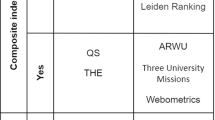Abstract
Ranking is widely considered to be an important tool for evaluating the performance, competitiveness, and success of academic institutions. An appropriate ranking system should evaluate the key missions of the higher education system in a way that helps to improve the leadership goals and activities carried out by the universities. Based on the concepts derived from the Iranian Higher Education Upstream Documents and Measures used internationally for university ranking, this study identifies 21 key measures that can be used in the ranking of Iranian universities. The measures are grouped into five categories: scientific infrastructure, scientific effectiveness, socio-cultural effectiveness, international interactions, and sustainability. Then, using the Interpretative Structural Modeling approach, the researchers develop a coherent rubric for establishing the ranking. The proposed conceptual model focuses primarily on the universities’ contribution to technological and scientific infrastructure, then secondarily on their contribution to scientific advancement and international interactions, and finally at a tertiary level on their socio-cultural effectiveness and sustainability.




Similar content being viewed by others
References
Almgren, E. (2009). Ranking of universities and higher education institutions for student information purposes?. Stockholm: Högskoleverket.
Altbach, P. G. (1998). Comparative higher education: Knowledge, the university, and development. Westport: Greenwood Publishing Group.
Ansell, B. W. (2008). University challenges: Explaining institutional change in higher education. World Politics, 60(2), 189–230.
Banadkoki, M. Z., Vahdatzad, M. A., Owlia, M. S., & Lotfi, M. (2015). The survey of university rankings: A critical approach. Majallah-i Amuzih-i Muhandisi-i Iran, 17(65), 95.
Barve, A., Kanda, A., & Shankar, R. (2008). Making 3PL effective in agile supply chains. International Journal of Logistics Systems and Management, 4(1), 40–60.
Çakır, M. P., Acartürk, C., Alaşehir, O., & Çilingir, C. (2015). A comparative analysis of global and national university ranking systems. Scientometrics, 103(3), 813–848.
Chan, L. K., & Wu, M. L. (2002). Quality function deployment: A literature review. European Journal of Operational Research, 143(3), 463–497.
Daraio, C., Bonaccorsi, A., & Simar, L. (2015). Rankings and university performance: A conditional multidimensional approach. European Journal of Operational Research, 244, 918–930.
Dill, D. D., & Soo, M. (2005). Academic quality, league tables, and public policy: A cross-national analysis of university ranking systems. Higher Education, 49(4), 495–533.
Drewes, T., & Michael, C. (2006). How do students choose a university? An analysis of applications to universities in Ontario, Canada. Research in Higher Education, 47(7), 781–800.
Global University Rankings (RatER, Rating of Educational Resources) [Russia]. (2012). http://www.globaluniversitiesranking.org/.
Huang, M. H. (2011). A comparison of three major academic rankings for world universities: From a research evaluation perspective. Journal of Library and Information Studies, 9(1), 1–25.
Kerr, C. (2001). The uses of the university. Cambridge: Harvard University Press.
Kezar, A. (2014). Higher education change and social networks: A review of research. The Journal of Higher Education, 85(1), 91–125.
Lukman, R., Krajnc, D., & Glavič, P. (2010). University ranking using research, educational and environmental measures. Journal of Cleaner Production, 18(7), 619–628.
Moed, H. F. (2017). A critical comparative analysis of five world university rankings. Scientometrics, 110(2), 967–990.
Performance Ranking of Scientific Papers for Research Universities (Higher Education Evaluation and Assessment Council of Taiwan, (HEEACT) [Taiwan]. (2017). http://nturanking.lis.ntu.edu.tw/.
Porzionato, M., & De Marco, F. (2015). Excellence and diversification of higher education institutions’ missions. In The European higher education area (pp. 285–292). Springer.
QS World University Rankings. (2017). https://www.topuniversities.com/.
Ranking of Islamic Countries Universities and Research Institutions ISC. (2016). http://iur.isc.gov.ir/.
Ravi, V., Shankar, R., & Tiwari, M. K. (2005). Production improvement of a computer hardware supply chain. International Journal of Productivity Performance Management, 54(4), 239–255.
Salmi, J., & Saroyan, A. (2007). League tables as policy instruments. Higher Education Management and Policy, 19(2), 1–38.
SCImago Institutions Rankings. (2015). http://www.scimagoir.com.
Shanghai Jiao Tong University. (2017). Academic ranking of world universities (ARWU). http://www.shanghairanking.com.
Shin, J. C., Toutkoushian, R. K., & Teichler, U. (Eds.). (2011). University rankings: Theoretical basis, methodology and impacts on global higher education (Vol. 3). Berlin: Springer.
Singh, M. D., & Kant, R. (2008). Knowledge management barriers: An interpretive structural modeling approach. International Journal of Management Science and Engineering Management, 3(2), 141–150.
Stromquist, N. P. (2007). Internationalization as a response to globalization: Radical shifts in university environments. Higher Education, 53(1), 81–105.
Times Higher Education Thompson Reuters World University Ranking (THE-TR) [UK]. (2016) http://www.timeshighereducation.co.uk/world-university-rankings/.
URAP-TR University Ranking by Academic Performance. (2015). http://tr.urapcenter.org/2015/.
URAP-University Ranking by Academic Performance. (2014). http://www.urapcenter.org/2014.
Universiteit Leiden. (2015). Leiden university rankings. http://www.leidenranking.com/ranking/2015.
Usher, A., & Savino, M. (2007). A global survey of university ranking and league tables. Higher Education in Europe, 32(1), 5–15.
Van Raan, A. F. (2005). Fatal attraction: Conceptual and methodological problems in the ranking of universities by bibliometric methods. Scientometrics, 62(1), 133–143.
Warfield, J. W. (1974). Developing interconnected matrices in structural modeling. IEEE Transcript on Systems, Men and Cybertics, 4(1), 51–81.
Zare, B. M. R., Vahdatzad, M. A., Owlia, M. S., & Lotfi, M. M. (2016). The study of effective measures for Iranian university rankings from upstream documents. Journal of Science and Technology Policy, 8(3), 55–70.
Author information
Authors and Affiliations
Corresponding author
Rights and permissions
About this article
Cite this article
Zare Banadkouki, M.R., Vahdatzad, M.A., Owlia, M.S. et al. Ranking Iranian universities: an interpretative structural modeling approach. Scientometrics 117, 1493–1512 (2018). https://doi.org/10.1007/s11192-018-2946-9
Received:
Published:
Issue Date:
DOI: https://doi.org/10.1007/s11192-018-2946-9




